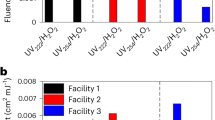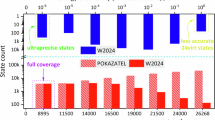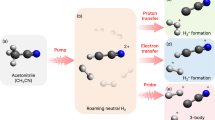Abstract
THE ultra-violet absorption in hydrazine vapour, N2H4 (saturation pressure over the liquid at room temperature), consists of five or six nearly equidistant intensity maxima at about 2326, 2320, 2276, 2250, 2225 A., followed by continuous absorption, beginning at about 2200 A. and extending into the whole quartz region.1 The band absorptions are entirely devoid of rotation structures at 5.4 A. per mm. dispersion.
This is a preview of subscription content, access via your institution
Access options
Subscribe to this journal
Receive 51 print issues and online access
$199.00 per year
only $3.90 per issue
Buy this article
- Purchase on SpringerLink
- Instant access to full article PDF
Prices may be subject to local taxes which are calculated during checkout
Similar content being viewed by others
References
Sci. Pap. Inst. Phys. Chem. Res., 15, 166; 1931
C.R. Acad. Sci., 188, 61; 1929.
Naturwiss., 18, 154; 1930.
Author information
Authors and Affiliations
Rights and permissions
About this article
Cite this article
IMANISHI, S. Ultra-Violet Absorption and Raman Effect for Hydrazine. Nature 127, 782 (1931). https://doi.org/10.1038/127782a0
Issue date:
DOI: https://doi.org/10.1038/127782a0



